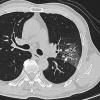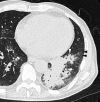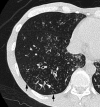A comparative study of thin-section CT findings between seasonal influenza virus pneumonia and Streptococcus pneumoniae pneumonia
- PMID: 24834476
- PMCID: PMC4075588
- DOI: 10.1259/bjr.20140051
A comparative study of thin-section CT findings between seasonal influenza virus pneumonia and Streptococcus pneumoniae pneumonia
Abstract
Objective: To compare the pulmonary thin-section CT findings in patients with seasonal influenza virus pneumonia with Streptococcus pneumoniae pneumonia.
Methods: The study group included 30 patients (20 males and 10 females; age range, 20-91 years; mean age, 55.9 years) with seasonal influenza virus pneumonia and 71 patients (47 males and 24 females; age range, 27-92 years; mean age, 67.5 years) with S. pneumoniae pneumonia.
Results: The proportion of community-acquired infection was significantly higher in patients with influenza virus pneumonia than with S. pneumoniae pneumonia (p = 0.001). CT findings of ground-glass attenuation (GGA) (p = 0.012) and crazy-paving appearance (p = 0.03) were significantly more frequent in patients with influenza virus pneumonia than with S. pneumoniae pneumonia. Conversely, consolidation (p < 0.001), mucoid impaction (p < 0.001), centrilobular nodules (p = 0.04) and pleural effusion (p = 0.003) were significantly more frequent in patients with S. pneumoniae pneumonia than in those with influenza virus pneumonia.
Conclusion: Pulmonary thin-section CT findings, such as consolidation and mucoid impaction may be useful in distinguishing between seasonal influenza virus pneumonia and S. pneumoniae pneumonia.
Advances in knowledge: (1) Distinguishing seasonal influenza virus pneumonia with S. pneumoniae pneumonia is important. (2) The CT findings of GGA and crazy-paving appearance were more frequently found in patients with influenza virus pneumonia than in patients with S. pneumoniae pneumonia, whereas consolidation, mucoid impaction, centrilobular nodules and pleural effusion were more frequently found in patients with S. pneumoniae pneumonia.
Figures





Similar articles
-
CT Manifestations of Coronavirus Disease (COVID-19) Pneumonia and Influenza Virus Pneumonia: A Comparative Study.AJR Am J Roentgenol. 2021 Jan;216(1):71-79. doi: 10.2214/AJR.20.23304. Epub 2020 Jul 9. AJR Am J Roentgenol. 2021. PMID: 32755175
-
Thin-section CT findings of patients with acute Streptococcus pneumoniae pneumonia with and without concurrent infection.Br J Radiol. 2012 Aug;85(1016):e357-64. doi: 10.1259/bjr/18544730. Epub 2012 Jan 3. Br J Radiol. 2012. PMID: 22215884 Free PMC article.
-
Differential diagnosis between the coronavirus disease 2019 and Streptococcus pneumoniae pneumonia by thin-slice CT features.Clin Imaging. 2021 Jan;69:318-323. doi: 10.1016/j.clinimag.2020.09.012. Epub 2020 Oct 6. Clin Imaging. 2021. PMID: 33045476 Free PMC article.
-
Interactions between Streptococcus pneumoniae and influenza virus: a mutually beneficial relationship?Future Microbiol. 2012 May;7(5):609-24. doi: 10.2217/fmb.12.29. Future Microbiol. 2012. PMID: 22568716 Review.
-
Viral Pneumonias.Radiol Clin North Am. 2022 May;60(3):383-397. doi: 10.1016/j.rcl.2022.01.010. Radiol Clin North Am. 2022. PMID: 35534126 Review.
Cited by
-
Phenotyping COPD exacerbations using imaging and blood-based biomarkers.Int J Chron Obstruct Pulmon Dis. 2018 Jan 8;13:217-229. doi: 10.2147/COPD.S152484. eCollection 2018. Int J Chron Obstruct Pulmon Dis. 2018. PMID: 29386890 Free PMC article.
-
Chest HRCT findings in acute transformation of adult T-cell lymphoma/leukemia.Eur Radiol. 2015 Jun;25(6):1607-13. doi: 10.1007/s00330-014-3565-3. Epub 2015 Jan 11. Eur Radiol. 2015. PMID: 25576228
-
Clinical Characteristics and CT Findings in 148 Non-COVID-19 Influenza-Like Illness Cases: A Retrospective Control Study.Front Public Health. 2021 Feb 9;9:616963. doi: 10.3389/fpubh.2021.616963. eCollection 2021. Front Public Health. 2021. PMID: 33634067 Free PMC article.
-
Epidemiological investigation and intergenerational clinical characteristics of 24 coronavirus disease patients associated with a supermarket cluster: a retrospective study.BMC Public Health. 2021 Apr 1;21(1):647. doi: 10.1186/s12889-021-10713-z. BMC Public Health. 2021. PMID: 33794836 Free PMC article.
-
Pulmonary melanoma and "crazy paving" patterns in chest images: a case report and literature review.BMC Cancer. 2016 Aug 3;16:592. doi: 10.1186/s12885-016-2630-5. BMC Cancer. 2016. PMID: 27488496 Free PMC article. Review.
References
-
- Craven DE, Steger KA. Epidemiology of nosocomial pneumonia. New perspective on an old disease. Chest 1995; 108(2 Suppl): 1S–16S. - PubMed
-
- Chastre J, Fagon JF. Pneumonia in the ventilator-dependent patient. In: Tobin M, ed. Principles and practice of mechanical ventilation. 1st edn. New York, NY: McGraw & Hill; 1994. pp. 857–90.
-
- American Thoracic Society. Hospital-acquired pneumonia in adults: diagnosis, assessment of severity, initial antimicrobial therapy, and preventive strategies: a consensus statement. Am J Respir Crit Care Med 1996; 153: 1711–25. - PubMed
-
- Dominguez J, Gali N, Blanco S, Pedroso P, Prat C, Matas L, et al. . Detection of Streptococcus pneumoniae antigen by a rapid immunochromatographic assay in urine samples. Chest 2001; 119: 243–9. - PubMed
Publication types
MeSH terms
LinkOut - more resources
Full Text Sources
Other Literature Sources
Medical

